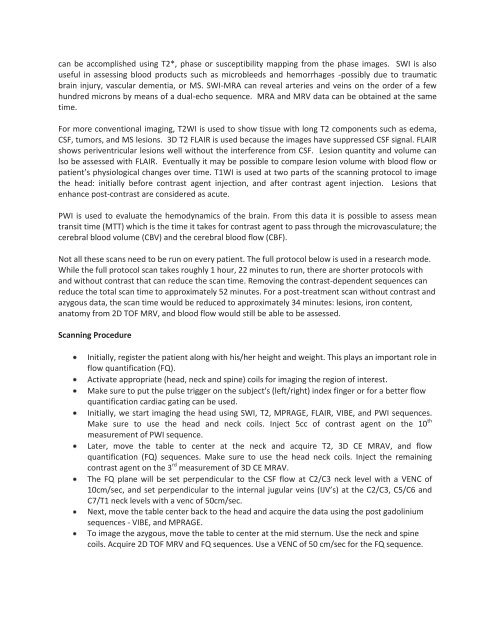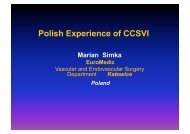ISNVD Abstract Book
ISNVD Abstract Book
ISNVD Abstract Book
Create successful ePaper yourself
Turn your PDF publications into a flip-book with our unique Google optimized e-Paper software.
can be accomplished using T2*, phase or susceptibility mapping from the phase images. SWI is also<br />
useful in assessing blood products such as microbleeds and hemorrhages -possibly due to traumatic<br />
brain injury, vascular dementia, or MS. SWI-MRA can reveal arteries and veins on the order of a few<br />
hundred microns by means of a dual-echo sequence. MRA and MRV data can be obtained at the same<br />
time.<br />
For more conventional imaging, T2WI is used to show tissue with long T2 components such as edema,<br />
CSF, tumors, and MS lesions. 3D T2 FLAIR is used because the images have suppressed CSF signal. FLAIR<br />
shows periventricular lesions well without the interference from CSF. Lesion quantity and volume can<br />
lso be assessed with FLAIR. Eventually it may be possible to compare lesion volume with blood flow or<br />
patient’s physiological changes over time. T1WI is used at two parts of the scanning protocol to image<br />
the head: initially before contrast agent injection, and after contrast agent injection. Lesions that<br />
enhance post-contrast are considered as acute.<br />
PWI is used to evaluate the hemodynamics of the brain. From this data it is possible to assess mean<br />
transit time (MTT) which is the time it takes for contrast agent to pass through the microvasculature; the<br />
cerebral blood volume (CBV) and the cerebral blood flow (CBF).<br />
Not all these scans need to be run on every patient. The full protocol below is used in a research mode.<br />
While the full protocol scan takes roughly 1 hour, 22 minutes to run, there are shorter protocols with<br />
and without contrast that can reduce the scan time. Removing the contrast-dependent sequences can<br />
reduce the total scan time to approximately 52 minutes. For a post-treatment scan without contrast and<br />
azygous data, the scan time would be reduced to approximately 34 minutes: lesions, iron content,<br />
anatomy from 2D TOF MRV, and blood flow would still be able to be assessed.<br />
Scanning Procedure<br />
Initially, register the patient along with his/her height and weight. This plays an important role in<br />
flow quantification (FQ).<br />
Activate appropriate (head, neck and spine) coils for imaging the region of interest.<br />
Make sure to put the pulse trigger on the subject's (left/right) index finger or for a better flow<br />
quantification cardiac gating can be used.<br />
Initially, we start imaging the head using SWI, T2, MPRAGE, FLAIR, VIBE, and PWI sequences.<br />
Make sure to use the head and neck coils. Inject 5cc of contrast agent on the 10 th<br />
measurement of PWI sequence.<br />
Later, move the table to center at the neck and acquire T2, 3D CE MRAV, and flow<br />
quantification (FQ) sequences. Make sure to use the head neck coils. Inject the remaining<br />
contrast agent on the 3 rd measurement of 3D CE MRAV.<br />
The FQ plane will be set perpendicular to the CSF flow at C2/C3 neck level with a VENC of<br />
10cm/sec, and set perpendicular to the internal jugular veins (IJV’s) at the C2/C3, C5/C6 and<br />
C7/T1 neck levels with a venc of 50cm/sec.<br />
Next, move the table center back to the head and acquire the data using the post gadolinium<br />
sequences - VIBE, and MPRAGE.<br />
To image the azygous, move the table to center at the mid sternum. Use the neck and spine<br />
coils. Acquire 2D TOF MRV and FQ sequences. Use a VENC of 50 cm/sec for the FQ sequence.




